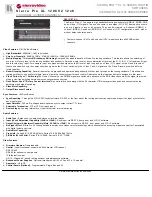
Installation Manual
H3C S9500 Series Routing Switches
Chapter 3 Switch Installation
3-26
Figure 3-27
LC connector
III. Precautions
z
Be sure to install the dust cover if the optical port is not connected to a fiber
connector.
z
Some invisible rays may be emitted from the optical port if the optical port is not
connected to a fiber connector or the dust cover is removed. Therefore, never
stare at the optical port directly.
z
Fiber connectors must be protected under safe and reliable outer packing, and be
fitted with dust caps. Fiber connectors must be installed with dust caps when they
are not in use. Take care not to scratch their end face. Replace the dust cap if it
loose or polluted.
z
Before connecting a fiber, use dustfree paper and absolute alcohol to clean the
end face of the fiber connector. You can brush the end face only in one direction.
You also need to brush the end face of the other fiber connector.
z
Never bend or curve a fiber when connecting it. After a fiber is installed well, the
bend radius must be not less than 40 mm (the minimum dynamic bend radius is 20
D, and the minimum static bend radius is 10 D. D indicates the outer diameter of
fiber jackets).
z
If the fiber has to pass through a metallic board hole, the hole must have a sleek
and fully filleted surface (the filleting radius must be not less than 2 mm). When
passing through a metallic board hole or bending along the acute side of
mechanical parts, the fiber must wear jackets or cushions.
z
Insert and remove a plug with care. Never exert a fierce force to the fiber or plug;
otherwise the plug may be damaged or the fiber may be broken. Never pull, press
or extrude the fiber fiercely. For the allowed maximum tensile load and crush load,
refer to Table 3-4.
Table 3-4
Allowed maximum tensile force and crush load
Period of force
Tensile load (N)
Crush load (N/100 mm)
Short period
150 500
Long term
80 100
















































